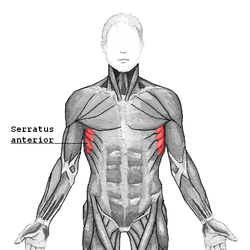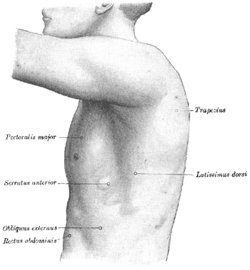Serratus anterior muscle
| Serratus anterior | |
|---|---|

Serratus anterior, showing origin from lower ribs (origin from upper ribs obscured by pectoralis major and other superficial muscles)
|
|

The left side of the thorax.
|
|
| Details | |
| Origin | fleshy slips from the outer surface of upper 8 or 9 ribs |
| Insertion | costal aspect of medial margin of the scapula |
| Artery | lateral thoracic artery (upper part), thoracodorsal artery (lower part) |
| Nerve | long thoracic nerve (from roots of brachial plexus C5, 6, 7) |
| Actions | protracts and stabilizes scapula, assists in upward rotation. |
| Antagonist | Rhomboid major, Rhomboid minor, Trapezius |
| Identifiers | |
| Latin | musculus serratus anterior, serratus lateralis |
| TA | A04.4.01.008 |
| FMA | 13397 |
|
Anatomical terms of muscle
[]
|
|
The serratus anterior (/ˌsᵻˈreɪtəs ænˈtiːri.ər/) (Latin: serrare = to saw, referring to the shape, anterior = on the front side of the body) is a muscle that originates on the surface of the 1st to 8th ribs at the side of the chest and inserts along the entire anterior length of the medial border of the scapula.
Serratus anterior normally originates by nine or ten slips (muscle branches) from either the first to ninth ribs or the first to eighth ribs. Because two slips usually arise from the second rib, the number of slips is greater than the number of ribs from which they originate.
The muscle is inserted along the medial border of the scapula between the superior and inferior angles along with being inserted along the thoracic vertebrae. The muscle is divided into three named parts depending on their points of insertions:
The serratus anterior lies deep to the subscapularis, from which it is separated by the subscapularis (supraserratus) bursa. It is separated from the rib by the scapulothoracic (infraserratus) bursa.
The serratus anterior is innervated by the long thoracic nerve (Nerve of Bell), a branch of the brachial plexus. The long thoracic nerve travels inferiorly on the surface of the serratus. The nerve is especially vulnerable during certain types of surgery (for example, during lymph node clearance from the axilla (e.g., in case of axillary dissection in a surgery for breast cancer)). Damage to this nerve can lead to a winged scapula.
...
Wikipedia
